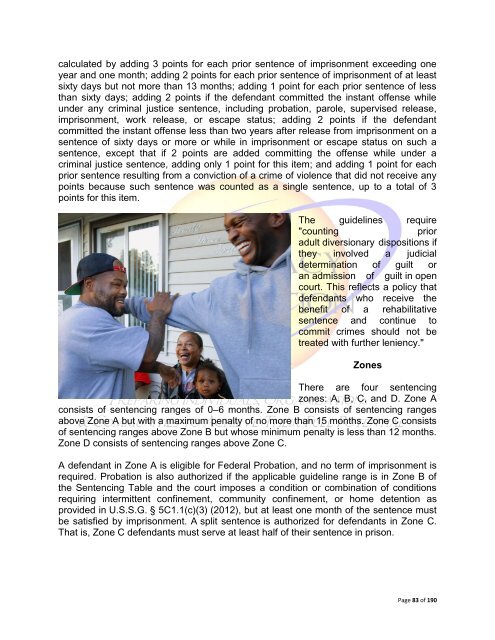The Violent Crime and Law Enforcement Act of 1994
The Violent Crime and Law Enforcement Act of 1994
The Violent Crime and Law Enforcement Act of 1994
Create successful ePaper yourself
Turn your PDF publications into a flip-book with our unique Google optimized e-Paper software.
calculated by adding 3 points for each prior sentence <strong>of</strong> imprisonment exceeding one<br />
year <strong>and</strong> one month; adding 2 points for each prior sentence <strong>of</strong> imprisonment <strong>of</strong> at least<br />
sixty days but not more than 13 months; adding 1 point for each prior sentence <strong>of</strong> less<br />
than sixty days; adding 2 points if the defendant committed the instant <strong>of</strong>fense while<br />
under any criminal justice sentence, including probation, parole, supervised release,<br />
imprisonment, work release, or escape status; adding 2 points if the defendant<br />
committed the instant <strong>of</strong>fense less than two years after release from imprisonment on a<br />
sentence <strong>of</strong> sixty days or more or while in imprisonment or escape status on such a<br />
sentence, except that if 2 points are added committing the <strong>of</strong>fense while under a<br />
criminal justice sentence, adding only 1 point for this item; <strong>and</strong> adding 1 point for each<br />
prior sentence resulting from a conviction <strong>of</strong> a crime <strong>of</strong> violence that did not receive any<br />
points because such sentence was counted as a single sentence, up to a total <strong>of</strong> 3<br />
points for this item.<br />
<strong>The</strong> guidelines require<br />
"counting<br />
prior<br />
adult diversionary dispositions if<br />
they involved a judicial<br />
determination <strong>of</strong> guilt or<br />
an admission <strong>of</strong> guilt in open<br />
court. This reflects a policy that<br />
defendants who receive the<br />
benefit <strong>of</strong> a rehabilitative<br />
sentence <strong>and</strong> continue to<br />
commit crimes should not be<br />
treated with further leniency."<br />
Zones<br />
<strong>The</strong>re are four sentencing<br />
zones: A, B, C, <strong>and</strong> D. Zone A<br />
consists <strong>of</strong> sentencing ranges <strong>of</strong> 0–6 months. Zone B consists <strong>of</strong> sentencing ranges<br />
above Zone A but with a maximum penalty <strong>of</strong> no more than 15 months. Zone C consists<br />
<strong>of</strong> sentencing ranges above Zone B but whose minimum penalty is less than 12 months.<br />
Zone D consists <strong>of</strong> sentencing ranges above Zone C.<br />
A defendant in Zone A is eligible for Federal Probation, <strong>and</strong> no term <strong>of</strong> imprisonment is<br />
required. Probation is also authorized if the applicable guideline range is in Zone B <strong>of</strong><br />
the Sentencing Table <strong>and</strong> the court imposes a condition or combination <strong>of</strong> conditions<br />
requiring intermittent confinement, community confinement, or home detention as<br />
provided in U.S.S.G. § 5C1.1(c)(3) (2012), but at least one month <strong>of</strong> the sentence must<br />
be satisfied by imprisonment. A split sentence is authorized for defendants in Zone C.<br />
That is, Zone C defendants must serve at least half <strong>of</strong> their sentence in prison.<br />
Page 83 <strong>of</strong> 190
















